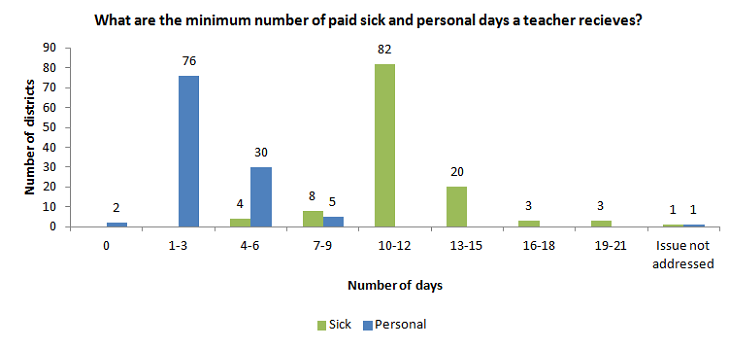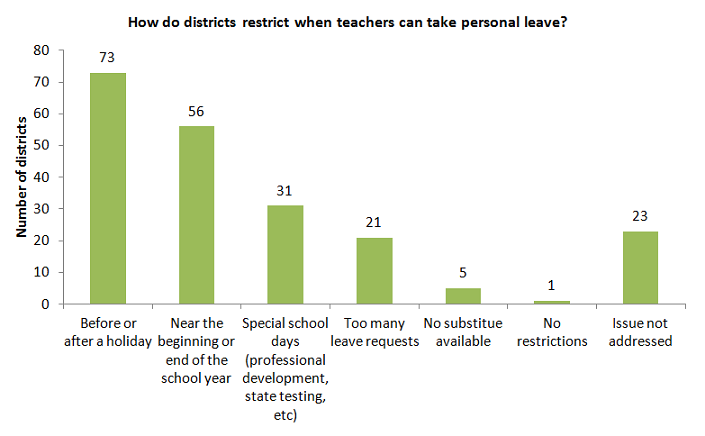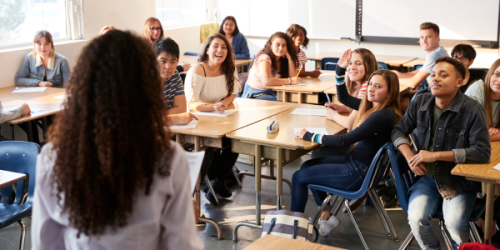District Trendline, previously known as Teacher Trendline, provides actionable research to improve district personnel policies that will strengthen the teacher workforce. Want evidence-based guidance on policies and practices that will enhance your ability to recruit, develop, and retain great teachers delivered right to your inbox each month? Subscribe here.
Anyone will agree that teacher
attendance is important. How much leave
time districts provide is an important data point to consider as districts seek
to strike a balance between the need for their teachers to be able to take time
off with students’ need to have their teacher present as much as possible.
This month’s Trendline examines how much sick and personal leave the nation’s biggest districts
give each year and also how they incentivize their teachers, through leave
carryover and buyback policies, to encourage the highest possible teacher
attendance.
General leave
From contract to contract, categories of leave vary
significantly. In order to fairly compare the amount of leave teachers receive
across districts, the Teacher Contract Database uses a category called “general
leave.” This includes any leave taken for routine, personal reasons,
including sick and personal leave and other reasons such as voting or religious
observances (more details on how leave is categorized in the Teacher Contract
Database here).
Across
the database, the average minimum amount of general leave districts offer
teachers is 13.1 days.

Hartford continues to offer
teachers the most general paid leave, providing 20 sick days and 5 personal
days for a total of 25 days. Toledo and Burlington (VT) also make the top of the list with 24 general leave days each. At
the other end of the spectrum, four districts (Davis (UT), Jefferson County (CO), Desoto County (MS) and Austin) offer teachers nine general
leave days. Hawaii is the only district in the database that does not specify the
amount of general leave a teacher receives and is not included in the graph
above.
One district has an extremely
unusual leave policy that offers the least leave to beginning teachers but
transforms into perhaps the single most generous general leave package for more
veteran teachers in our database. In the graph above, Alpine (UT) is counted as offering eight days of general leave to new teachers,
the lowest in the database. After three years of experience, however, teachers
receive 180 days of “health and disability” leave to draw down from
over the course of multiple years, with no limit on how many days can be used
in a single year.[1]
After using up all 180 days, the teacher transitions to a new leave package of 21
days of general leave per year but only for two years. After that two-year
period expires, the teacher is again eligible for another leave bank of 180
days.
Sick and personal
leave
As we break down the components of general leave, the
majority of districts in the database offer teachers separate allocations of sick
and personal leave, but in practice the two types of leave appear to be
generally interchangeable. Technically
speaking, only 36 percent of the districts allow teachers to take personal days
from their sick leave and 6 percent make no distinction between sick and
personal days.

As shown below, districts commonly offer much less personal
leave to teachers than sick leave, assuming that most teachers will use
vacation days to take care of their personal needs not related to illness.
Teachers receive a minimum of 10 to 12 sick days per year in 82 districts in
our database. The most common amount of time off districts give teachers for
personal reasons is 1 to 3 days.

Teachers in Sacramento receive nine days for personal leave, the most of any district in the database. Neither Jefferson County (CO) nor Pittsburgh offers beginning teachers any personal days, but they provide two personal days to experienced teachers. Of course, the seven districts that offer teachers general days to use at their discretion technically offer more personal leave than Sacramento, as teachers in those districts have 10 to 13 days of leave per year, be the reasons for leave due to illness or a variety of personal needs.
Leave restrictions
The majority of districts in the database (79 percent) place
some restrictions on when personal leave can be taken. These restrictions
include before or after a holiday, specified days at the beginning and end of
the school year or special days such as professional development days or state
testing days. A smaller number of districts restrict leave when it will create
a burden on staffing the school as determined by either the unavailability of a
substitute or if a certain amount of school staff have already requested leave.

Leave carry over
All of the districts in our database allow sick leave to
carry over to the next year, with the exception of Hawaii, which does not address this issue in its teacher contract. In
most districts in the database (73 percent) there is no maximum limit on the
number of sick days a teacher can accrue.
Within the 85 districts that offer teachers separate
allocations of sick and personal leave, most (64 districts) try to incentivize
their teachers to not use their personal days. Some districts (35) allow unused
personal days to carry over to the following year, others convert unused
personal days to sick days (28 districts), and two districts (Dayton and Toledo) even pay
teachers for unused days at the end of the year.

Payouts for unused
leave
Teachers can receive payouts for unused sick leave in almost
all of the districts (79 percent) in the database. A majority of those
districts delay the payout until the end of teachers’ careers.
A smaller portion of districts (14 percent)
offer teachers an opportunity to cash out unused sick leave at either the end
of the year or at retirement. In Anchorage, the District of Columbia, Green Dot Charters and Los Angeles, teachers receive
payment for unused sick leave at the end of the school year.

As school districts around the country continue to struggle
with substitute
teacher shortages, Teacher Trendline
will keep an eye out for districts using leave policies and attendance
incentives in thoughtful ways. To learn
more about teacher attendance policies, see the analysis in Roll Call: The importance of teacher
attendance and be on the lookout for a follow-up study next year.
[1]
Teachers who establish “… a pattern of sick leave use which might indicate a
possible misuse, may have the reasons for leave reviewed by a panel consisting
of three administrators to be appointed by the Superintendent… In the event it
is determined that the benefit is being misused, the panel will make
recommendations for action to the Superintendent and to the employee.”
(Alpine’s contract,
Policy Number 4019)
More like this

Does paid parental leave for teachers pay off?

The data and analyses district leaders used to support their work in 2024

Myth-busted: Teachers don’t skip school

